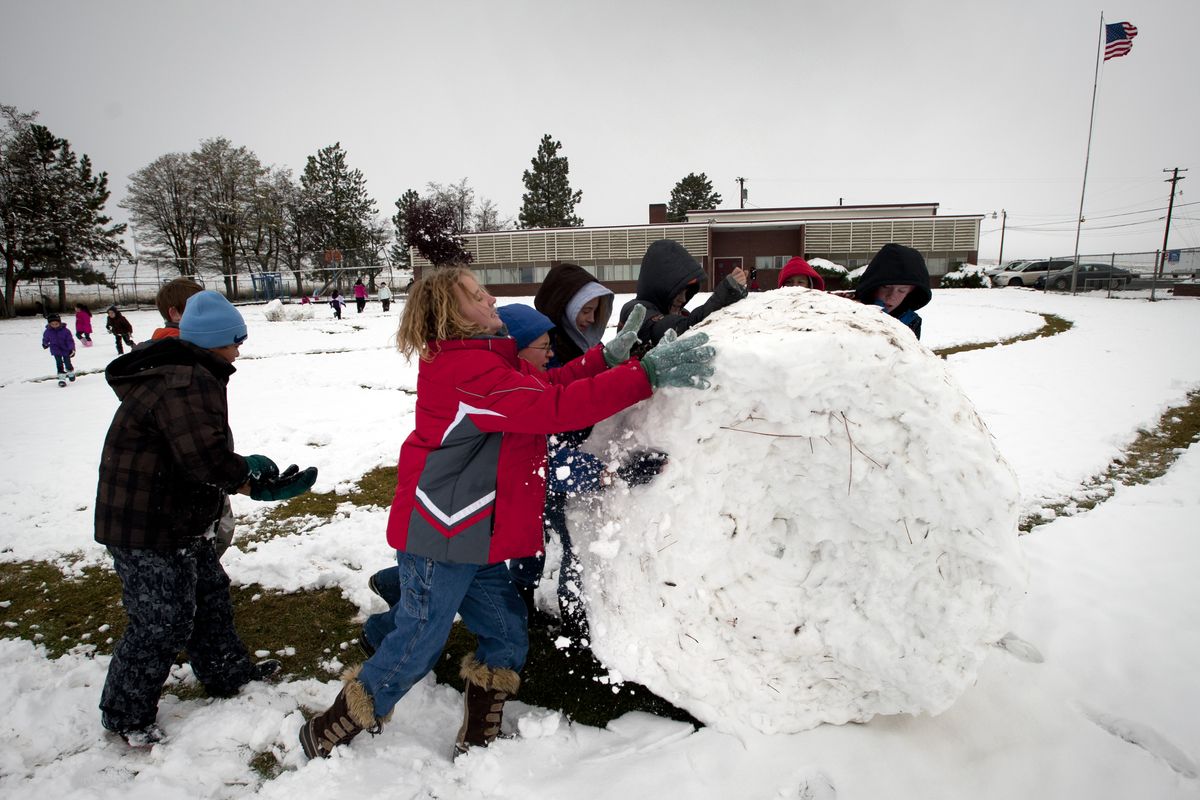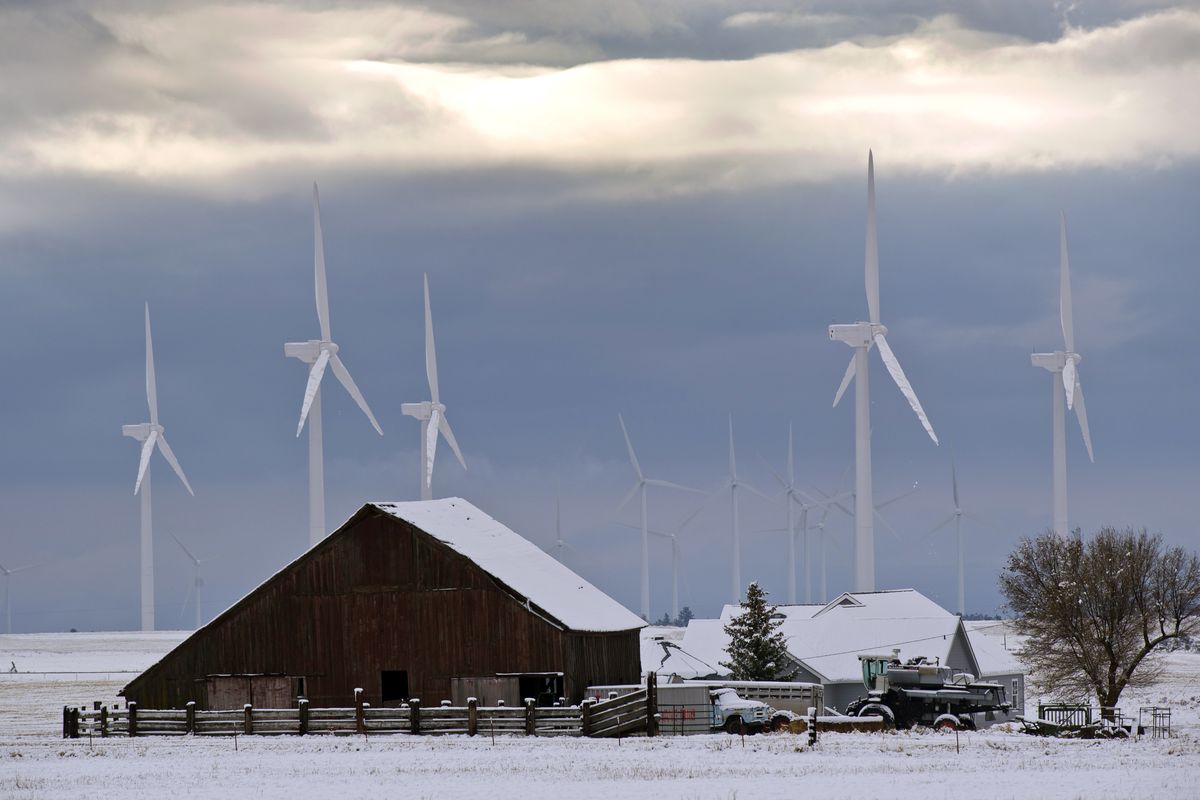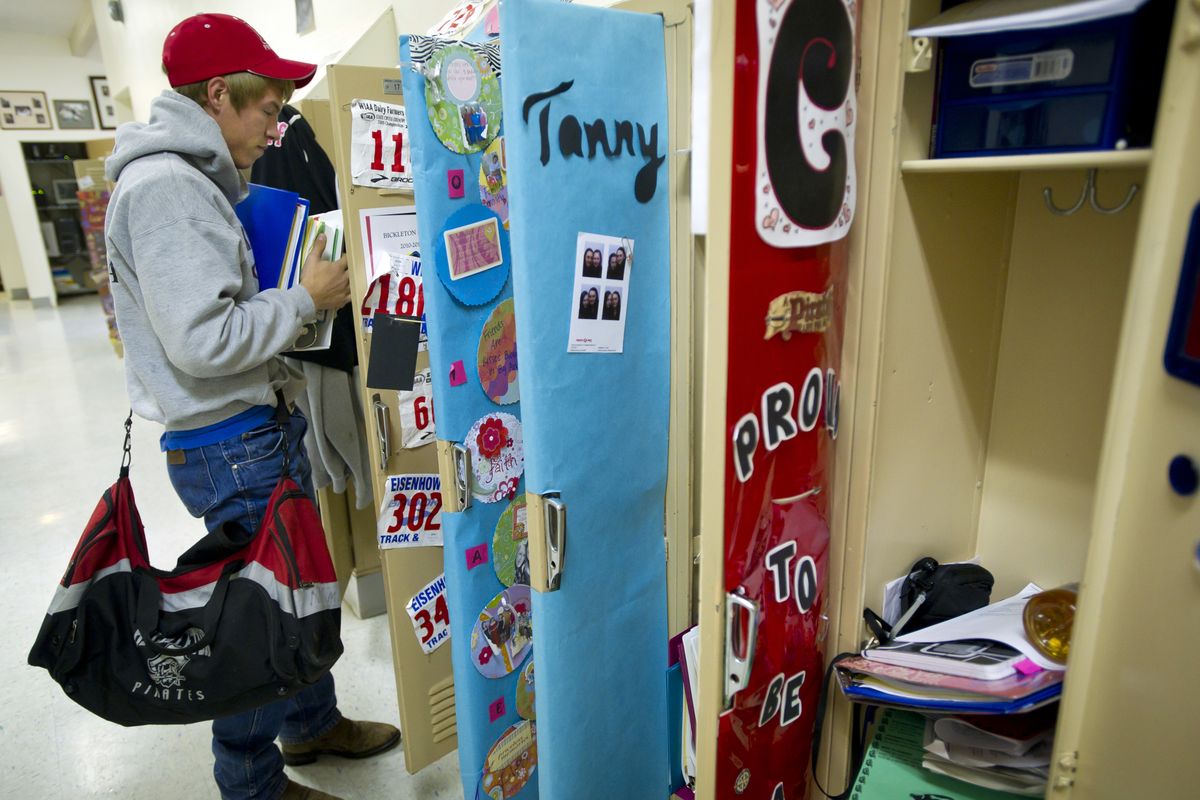At 82 students, school district credits size for academic success
Bickleton School District also credits a new industry for financial stability
On the outskirts of Bickleton, Wash., windmills have been sprouting up on farms. The green energy source has been a boon to the small town, which is using some of the increased property tax revenue to fund a new $10.4 million K-12 school. (Colin Mulvany / The Spokesman-Review)
BICKLETON, Wash. – A recent report calls rural education “what works in Washington.”
That’s certainly true in south-central Washington’s Bickleton School District, which has academic and financial strengths that could make it the envy of any district in the state.
The 82-student Bickleton district boasts a 100 percent graduation rate; 78 percent of the students in seventh through 12th grades achieve a 3.0 grade-point average or better; and 90 percent of the students move on to higher education.
Now, a new revenue stream – windmills – is helping the remote district fund construction of a state-of-the-art K-12 school.
“In Bickleton, you have to want to fail. Their teachers get on them, their coaches. We pull them aside, talk to the parents,” said Superintendent Ric Palmer. “We find solutions so they have a successful education experience.”
Close-knit, ‘all basically related’
The lockers at Bickleton High School stand open; no one worries about theft. Every face in the K-12 school is familiar, there are no cliques – and no cell phone service.
Katelynn Clinton, 18, does have one complaint. The boyfriend potential at Bickleton High School is limited, with just 11 boys in grades nine through 12.
“We are all pretty close, and we are all basically related,” she said, noting that her brother and a couple cousins are among her male classmates.
Three of her classes – drama, cooking and math – are taught by her mother, Kim Clinton.
“Oh. And have you met the business manager? That’s my grandma,” Katelynn said.
But the young woman doesn’t begrudge her experience in the rural district. She’s academically confident – a 3.95 GPA – and was just accepted to Washington State University.
Bickleton requires students to complete 26 credits, which exceeds the requirements of both the state and Spokane Public Schools.
High school requirements in Spokane’s largest district, in fact, “are less than what’s needed to get into college,” said Spokane Public Schools Superintendent Nancy Stowell, something the district tells incoming freshmen.
For Spokane to require 26 credits, the district would need an additional class period per day, Stowell said.
Bickleton’s extended day – 8 a.m. to 3:40 p.m. – accommodates the higher credit requirement and is possible because of the district’s four-day school week. The Monday-through-Thursday schedule was instituted last winter to reduce transportation costs in the 500-square-mile district.
Smaller class sizes also contribute to the students’ academic success. The average class size in so-called “rural remote” districts is five to 10 students, which can be an ideal teaching environment, many educators say. “It’s easier to tell if someone isn’t catching on,” said Bickleton elementary teacher Julie McBride, 46. With a computer for every two students, good kids and supportive families, “Bickleton is pretty ideal, really,” she said.
Jayce Alexander, 11, moved to the district a year ago. “Since it’s a smaller group, my teachers can help me. It’s really helped me with my reading and math,” the fifth-grader said.
Clinton’s high school physics class consists of five students. During a recent class, while the students worked on problems, there was an open discussion about how they found solutions. If there was still uncertainty, the teacher was there to guide them.
“Can we have an answer check, Mrs. (Barbara) Seymour?” one student asked. “What did you get?” the teacher replied. The student admitted she had two answers. When neither was correct, the four other students chimed in along with Seymour to lead her to the answer.
“This is a special school,” Seymour said.
Randy Dorn, Washington’s superintendent of public instruction, says he’s a small-schools advocate. “There’s less of a chance of a student falling through the cracks. There’s more of a chance for a student to develop a relationship, and we know that’s the No. 1 reason for a student staying in school.”
Urban schools have frequently tried to duplicate that small-school atmosphere. Spokane Public Schools, for example, has several programs that use a “schools-within-schools” model, including the On-Track Academy credit retrieval program for juniors and seniors, Havermale alternative high school, and LC Core at Lewis and Clark High School, which pairs struggling students with teachers.
“The teachers really get to know the parents and students. They build relationships with those parents,” Stowell said. But generally, “in big, comprehensive high schools like ours where teachers have 150 students every day, they have a harder time of doing that.”
In addition, some educators believe the schools-within-schools approach has a downside of further segregating struggling students from the mainstream.
Rural school districts in Washington have the highest average of on-time graduates, according to a recent study by the Rural Education Center at Washington State University. But Bickleton is still a standout among comparable districts.
The 77 Washington schools that fit into the “rural remote” category – 25 miles from an urbanized area – have an average graduation rate of 77.4 percent, the study states.
“If a student starts to slip in a subject, we pull them out and catch them up,” said Palmer, the Bickleton superintendent. “Even though we’re rural, we produce a good product. We don’t have all the bells and whistles. We are what we are.”
Windfall from windmills
Voters in the Bickleton School District approved a $10.4 million bond to build a new school last year; Palmer says the knowledge that wind turbines have increased property values, and likely will continue to do so, helped prompt those “yes” votes.
“The windmills – they are huge for us in this unstable economy,” he said.
Oregon, Washington and California have all agreed to use a higher amount of renewable energy sources such as wind, solar and geothermal, said Michael Milstein, a spokesman for the Bonneville Power Administration. Consequently, windmills dot the hillsides along the Columbia River Gorge and in other high-wind areas of the state.
So far, about 800 turbines have gone up on wheat farms in Klickitat County where Bickleton is located, which has increased property values there by about $600 million in four years.
“The project they’ve done has paid for what we need,” Palmer said. “The rest is gravy.”
The forecast is for as many as 3,000 to 5,000 wind turbines for the area.
“If all the towers go up that they are talking about, that will increase the tax base to about $1.2 billion,” Palmer said.
The Oakesdale School District, a wheat farming community about 30 miles southwest of Spokane in Whitman County, and the Pomeroy School District in Columbia County, about 100 miles farther south, could soon benefit from the same financial windfall. Wind turbine projects in both of those regions are in the planning stages.
In the Oakesdale area, First Energy LLC is asking for permits to put up 50 windmills on 5,000 acres of farmland, according to previous news reports.
The superintendent of the 120-student district says the project is so new he hasn’t determined what it will mean for schools financially. Nor have district officials in Pomeroy – with about 300 students – who expect about 440 of the turbines to be online in 2013.
But education officials in both districts realize it will be easier to go to voters for money.
“We would continue to ask for what’s needed, but nothing more,” said Pomeroy Superintendent Kim Spacek.
“Whenever your tax base can increase, that’s a good thing,” Oakesdale Superintendent Jake Dingman said of the windmills. “If the tax base increases, it (what people pay for school bonds and levies) goes down.”
The last time the Bickleton School District asked for a bond or a levy was in 1960, the business manager there said.
Last year, the schools’ heating and cooling systems began failing, and increased traffic made it dangerous for children to cross the street between the elementary and middle and high schools. Orange pylons mark the crosswalk frequently used by students going between the buildings; with the development of wind farms in Bickleton, the road that divides the shared schools has become busy with trucks, trailers and workers’ vehicles.
“It’s getting too dangerous for those kids crossing the road,” said Judy Naught, the district’s business manager.
“Getting them all under one roof was a major issue,” Palmer said.
The new K-12 school is expected to open in fall 2011.
Palmer was relieved to have a new tax base that helped make the bond issue palatable to voters.
“The last thing I wanted to do was bankrupt the district or the community,” he said. “I didn’t want to be known for that.”






